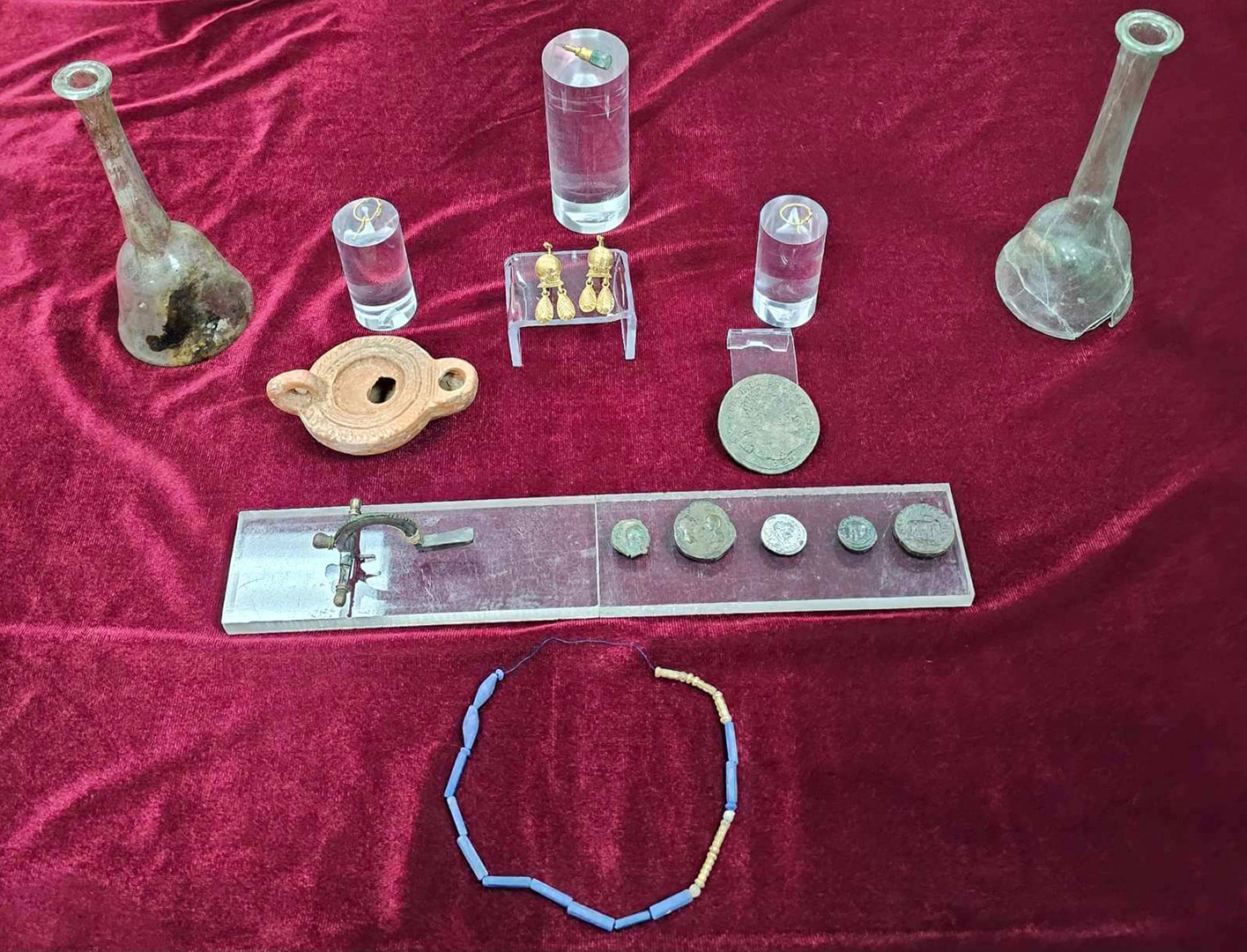Parádní článek i když trochu smutný...👍
A tractor driver ploughed up two richly furnished tombs from the Roman period
Categories: Nálezy nejenom s detektorem kovů ve východní Evropě
A tractor driver discovered two Roman tombs with rich equipment in a field near Nova Varbovka, Bulgaria, while ploughing. Among other things, a rare bronze medallion of Emperor Caracalla. It is a double burial of an adult male and female, the second grave belonged to a small child. The grave furnishings date the burials to the first half of the third century.
The graves were discovered last autumn by a tractor driver when he hit a limestone slab while ploughing a field. As soon as he saw human bones, he reported the discovery to the mayor. He passed the information on to the police, thinking it might be a criminal matter. When archaeologists from the Veliko Tarnovo Regional Historical Museum examined the remains and found that they were from the Roman period, they launched an urgent rescue archaeological excavation.
During the excavation, two large graves with brick walls and plaster on the inner walls were uncovered. They were covered with heavy limestone slabs. In the larger grave, about three metres long, lay the remains of a 45-49 year old woman and a man who died aged between 50 and 60. The child's grave was slightly older and contained the remains of a child of only two or three years of age. It may have been a parent and their child, whom they themselves had buried earlier.
In the adult grave a pair of gold ladies earrings, a gilded glass bead pendant, a lapis lazuli and gold necklace, and a silver plated fibula were discovered. The child was buried with a pair of gold earrings, glass bead jewellery, a ceramic wine amphora and a rarem bronze medallion minted by Emperor Caracalla (198-217) to commemorate his visit to the Pergamon temple of Asclepius in 214.
In addition to jewellery and gold, six coins dating from 200 to 225 AD were discovered, as well as a lamp, a leather shoe and several glassincluding three small glass lacrimaria, which were special ceremonial vessels for the tears of the mourners. "I think it's a sad family story from the first half of the 3rd century," said Kalin Chakarov, the excavation's leader and an archaeologist at the Veliko Tarnovo Regional History Museum. "A dead child, buried by his parents, who found his final resting place where they had previously buried their child."
Such luxurious grave furnishings were only available to very wealthy people in this time and place. Some of the limestone came from a quarry near Nicopolis ad Istrum, a Roman city founded by Trajan in the 2nd century, located about 35 km from the site. Archaeologists assume that the adults were wealthy landowners from Nicopolis ad Istrum who had a villa rustica (rural summer residence) there.
"The discovery of these tombs on the territory of Bulgaria is not a surprise, as the climate and soil are very favorable for growing agricultural crops," Ivan Tsarov, director of the Veliko Tarnovo Regional History Museum, told Live Science. "These are probably the tombs of rich landowners, because in the province of Moesia Inferior it was customary to ownlandowners lived on their estates during the warmer months of the year, where they were also buried," he added.
According to experts, Caracalla's medallion could point to the origin of the deceased from Asia Minor, which would be consistent with the fact that Nicopolis ad Istrum was built mainly by settlers from that region: "Of course, we are looking for an opportunity to conduct DNA and other analyses that our museum cannot afford to do to see if this hypothesis is correct," Chakarov concluded.
Roman Nemec
Sources: thehistoryblog.com, livescience.com

grave equipment

gold and lapis lazuli necklace

portrait of Emperor Caracalla

other side

one of the limestone slabs covering the tomb

brick double tomb
The article is included in categories:
- Archive of articles > Archaeology > Finds and rescue research abroad > Nálezy nejenom s detektorem kovů ve východní Evropě
Post
Jen se zeptám, proč u té zlaté spony není možnost komentáře ? 🤔
Ahoj, nevím, proč tam nejde komentovat? :(
Zřejmě měl autor článku krásný zážitek, když napsal místo orání pole...orální pole.



 sem si ani nevšiml... 😁
sem si ani nevšiml... 😁
Sorry chlapci, měli jsme tam drobnou chybku. Díky za upozornění a komenty už normálně beží :)
Proč "fibula"? To slovo se už tak minimálně 100 let nepoužívá - nezní "spona" líp?
Fibula se používá furt.
Zaorálek se omlouvám. 
Davide, to slovo je krásný. Když řekneš "našel jsem krásnou, stříbrem zdobenou fibulu", tak to je něco. :)
No, mně to rve uši a měl bych strach, aby to nebylo nakažlivé  , ale to není důležité. Terminologie by měla být jednotná. Proč se tedy jinde píše o sponách? Navíc, to už místo seker můžeme používat palstav
, ale to není důležité. Terminologie by měla být jednotná. Proč se tedy jinde píše o sponách? Navíc, to už místo seker můžeme používat palstav 
Silá myšlenky, nespočívá v počtu následovníků.
Remus Lupin
P.S: palstav klidně používej :)













